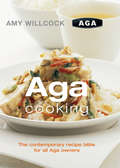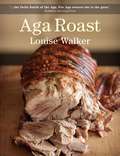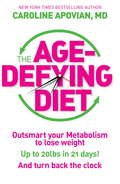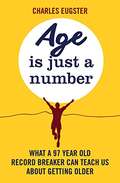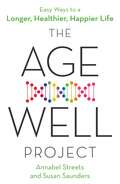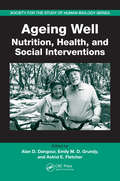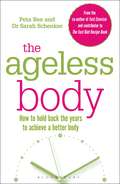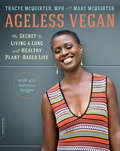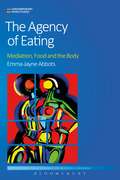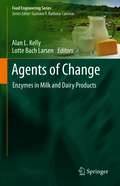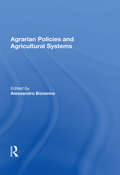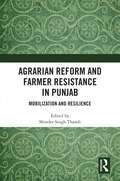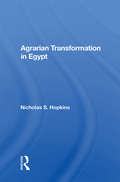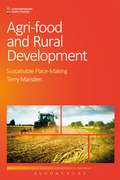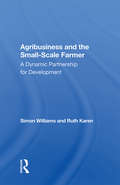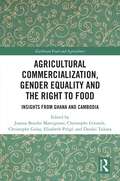- Table View
- List View
Aga Cooking: The Contemporary Recipe Bible For All Aga Owners
by Amy WillcockThe Aga is both a timeless design classic and a sleek new style object, increasingly attractive to an affluent new audience who are looking for more contemporary recipe ideas. Aga Cooking will be the new bible for both existing Aga owners and new fans. The author Amy Willcock draws on her experience of running Aga cookery courses to share all the essential secrets for getting the best out of your machine, as well as trouble-shooting tips and hints. Fantastic recipes range from asparagus and mint frittata to Thai chicken curry and chicken baked in focaccia. With the Aga seal of approval, this is the book no Aga should be without.
Aga Roast
by Louise WalkerFollowing on from the success of her brilliant Aga Year cookbook, Louise Walker tackles the favourite meal of Aga owners everywhere: the Sunday roast Lavish photography illustrates over 70 recipes for all things roasted. Drawing on inspiration from Britain and beyond, Louise Walker showcases a rich array of old and much-loved favourites, many with a satisfyingly delicious twist, alongside more exotic roasted dishes from Europe, North Africa, the Middle East, and beyond. There are master classes on jointing, carving, and serving, as well as a wealth of stuffings and accompaniments. To round off the book, Louise includes some invaluable and timely ideas for what to do with your roasted leftovers. Aga Roast is a stunning and significant addition to any Aga library.
Aga Roast
by Louise WalkerFollowing on from the success of her brilliant Aga Year cookbook, Louise Walker tackles the favourite meal of Aga owners everywhere: the Sunday roast Lavish photography illustrates over 70 recipes for all things roasted. Drawing on inspiration from Britain and beyond, Louise Walker showcases a rich array of old and much-loved favourites, many with a satisfyingly delicious twist, alongside more exotic roasted dishes from Europe, North Africa, the Middle East, and beyond. There are master classes on jointing, carving, and serving, as well as a wealth of stuffings and accompaniments. To round off the book, Louise includes some invaluable and timely ideas for what to do with your roasted leftovers. Aga Roast is a stunning and significant addition to any Aga library.
The Age-Defying Diet: Outsmart Your Metabolism To Lose Weight--up To 20 Pounds In 21 Days!--and Turn Back The Clock
by Caroline ApovianTHE AGE-DEFYING DIET provides a revolutionary solution to unwanted weight increase in your 40s and 50s. NEW YORK TIMES bestselling author, Dr Caroline Apovian, has developed a ground-breaking programme that outsmarts the body's ageing processes and enables readers to reverse the metabolic clock. New studies show that ageing changes the nutritional needs for both men and women in drastically different ways. Muscle loss, which naturally comes with age, thwarts efforts to fight fat and slows metabolism. Diets that seemed to work in your 20s and 30s only sabotage your efforts in your 40s and 50s by slowing your metabolism and leading to dangerous yo-yo dieting. Dr Caroline Apovian has the solution to the unwanted weight increase: Metabolism Reboot. Drawing on her clinical experience and the latest science and research, Dr. Apovian has created a simple 3-week plan that reveals exactly how to combat the effects of aging. By combining the powerful metabolism-boosting effects of intermittent fasting with targeted strength-training exercises, readers will lose weight fast, but they will also fix common complaints of ageing, including night sweats for women and low-testosterone for men. THE AGE-DEFYING DIET will help you burn fat, have more energy and look younger.
Age is Just a Number: What a 97 year old record breaker can teach us about growing older
by Charles EugsterRetired dental surgeon Charles Eugster rekindled a love of competitive rowing he'd neglected for most of his adult life at the age of 63. He took up bodybuilding at the age of 87. And at the age of 95 he started sprinting for the first time in his life, becoming World Champion at 200m indoor and 400m outdoor. He is a world record holder for his age group in a number of sports, and has 40 Gold Medals for World Masters Rowing. In this book, Charles shares his journey and his passionate belief that growing older needn't slow you down. And he shows his readers how taking on new challenges, learning new things, and improving your body as it ages is not only fun, but rewarding for the individual, and beneficial to society.
The Age-Well Project: Easy Ways to a Longer, Healthier, Happier Life
by Susan Saunders Annabel Streets'The essential mid-life mum makeover. From fitness to sleep and even your social life, a brilliant new book by two 50-something mothers reveals how to protect your health and happiness' Daily Mail'Educational and informative' Woman's WayDiseases of older age take root decades before symptoms appear. For a longer, happier life, we need to plan ahead - but what exactly should we do?For five years, Annabel Streets and Susan Saunders immersed themselves in the latest science of longevity, radically overhauling their lives and documenting their findings on their popular blog.After reading hundreds of studies and talking to numerous experts, Annabel and Susan have compiled almost 100 short cuts to health in mid and later life, including: how, when and what to eat; the supplements worth taking; when, where and how to exercise; the most useful medical tests; how to avoid health-threatening chemicals; the best methods for keeping the brain sharp; and how to sleep better.The Age-Well Project is an essential handbook for making the second half of your life happy, healthy and disease-free.
Ageing Well: Nutrition, Health, and Social Interventions
by Alan D. Dangour Astrid E. Fletcher Emily M. D. GrundyMany current public health actions and policies aimed at older people revolve around the often prevailing view that failing health is a consequence of ageing. It is now clear that it is possible to postpone or even prevent much of the age-related decline in health that was once thought inevitable. Future policies must recognise this changing paradi
The Ageless Body: How To Hold Back The Years To Achieve A Better Body
by Peta Bee Dr Sarah SchenkerDiscover the new goals and new rules that are the route to a healthier, better looking and better functioning body. For life.From Gwen Stefani and Cameron Diaz to Jennifer Aniston and Naomi Watts, a new breed of 40 and 50 plus women are redefining not just what an ageless body looks like, but what's entailed in achieving it. A dramatic shift in body expectations in the last few years means that, despite being plagued by a slowing metabolism and a naturally-occurring loss of muscle mass, pre- and post-menopausal women can realistically aim for the healthy, well-functioning body they crave as well as a physique that looks good with a flat stomach and sculpted arms.Peta Bee and Dr Sarah Schenker are the living embodiment of this new breed of woman: both in their forties with children, both with hectic careers and social lives. And both with the same bodies they had in their 30s. What matters, they have discovered through self-experimentation and trawling the scientific literature, is how you go about holding back the years. And the rules - for both exercise and diet - have changed.
The Ageless Body: How To Hold Back The Years To Achieve A Better Body
by Peta Bee Sarah SchenkerDiscover the new goals and new rules that are the route to a healthier, better looking and better functioning body. For life.From Gwen Stefani and Cameron Diaz to Jennifer Aniston and Naomi Watts, a new breed of 40 and 50 plus women are redefining not just what an ageless body looks like, but what's entailed in achieving it. A dramatic shift in body expectations in the last few years means that, despite being plagued by a slowing metabolism and a naturally-occurring loss of muscle mass, pre- and post-menopausal women can realistically aim for the healthy, well-functioning body they crave as well as a physique that looks good with a flat stomach and sculpted arms.Peta Bee and Dr Sarah Schenker are the living embodiment of this new breed of woman: both in their forties with children, both with hectic careers and social lives. And both with the same bodies they had in their 30s. What matters, they have discovered through self-experimentation and trawling the scientific literature, is how you go about holding back the years. And the rules - for both exercise and diet - have changed.
Ageless Vegan: The Secret to Living a Long and Healthy Plant-Based Life
by Tracye McQuirterHarness the healing power of plant-based foods for vibrant health and longevityVegan lifestyle expert Tracye McQuirter teams up with her mother Mary to share their secrets for maintaining radiant health for more than 30 years (hint: it's all in the greens), and 100 of their favorite plant-based recipes that have kept them looking and feeling ageless. They break down the basics of nutrition, how to build a vegan pantry, and how to make sure you're getting the best nutrients to promote longevity and prevent chronic disease. They also provide a 14-step guide with practical, easy-to-follow advice on how to transition to vegan foods, jumpstart your healthy eating habits, and how to up your game if you're already a vegan. Their 100 fresh, simple, and flavorful recipes are based on everyday whole food ingredients, including Maple French Toast with Strawberries, Thai Coconut Curry Soup, Cajun Quinoa with Okra and Tomato, Vegetable Pot Pie, Citrusy Dandelion Greens Salad, and Perfect Pecan Pie. Illustrated with beautiful, full-color photographs, Ageless Vegan helps you kiss diet-related disease and fatigue goodbye and gives you the information, inspiration, and affirmation you need to live a long, glowing, and healthy life you love.
The Agency of Eating: Mediation, Food and the Body (Contemporary Food Studies: Economy, Culture and Politics)
by Emma-Jayne AbbotsDeciding what to eat and how to eat it are two of the most basic acts of everyday life. Yet every choice also implies a value judgement: 'good' foods versus 'bad', 'proper' and 'improper' ways of eating, and 'healthy' and 'unhealthy' bodies. These food decisions are influenced by a range of social, political and economic bioauthorities, and mediated through the individual 'eating body'. This book is unique in the cultural politics of food in its exploration of a range of such bioauthorities and in its examination of the interplay between them and the individual eating body. No matter whether they are accepted or resisted, our eating practices and preferences are shaped by, and shape, these agencies. Abbots places the body, materiality and the non-human at the heart of her analysis, interrogating not only how the individual's embodied eating practices incorporate and reject the bioauthorities of food, but also how such authorities are created by the individual act of eating. Drawing on ethnographic case studies from across the globe, The Agency of Eating provides an important analysis of the power dynamics at play in the contemporary food system and the ways in which agency is expressed and bounded. This book will be of great benefit to any with an interest in food studies, anthropology, sociology and human geography.
Agents of Change: Enzymes in Milk and Dairy Products (Food Engineering Series)
by Alan L. Kelly Lotte Bach LarsenThe enzymology of milk and other products is of enormous significance for the production and quality of almost every dairy product. Milk itself is a complex biological fluid that contains a wide range of enzymes with diverse activities, some of which have identifiable functions while others are present as an accidental consequence of the mechanism of milk secretion. Over time milk enzymology has become an incredibly essential component of milk and other dairy product production, and with advancing technology and processing techniques, its importance is at its peak. Dairy Enzymology presents an expansive overview of the enzymology of milk and other dairy products, focusing on the use of indigenous and endogenous enzymes in milk and exogenous enzymes in cheese processing. A full section is dedicated to the enzymology of bovine milk, focusing on the main families of indigenous enzymes as well as their potential significance in the mammary gland plus the technological significance for the properties of dairy products. Implications for the manufacture and ripening of cheese plus the use of enzymes such as alkaline phosphatase for measuring heat treatment in milk are explored in full, and the role of milk protease plasmin and other indigenous enzymes in the age-gelation is focused on. Further sections focus on enzymes found in raw milk and enzymes deliberately added for manufacture or modification of properties and the manufacture of food ingredients from dairy-derived ingredients. The key bacterial families are discussed in depth as well as their known contributions to the quality of dairy products. With its comprehensive scope and fully up-to-date coverage of dairy product enzymology, this text is a singular source for researchers looking to understand this essential dairy processing aspect.
Aging: How Science Works
by Carsten Carlberg Eunike Velleuer Stine M. UlvenAging is a topic that concerns all of us, since none of us can escape it. The molecular and cellular process is built in every of the billions of cells forming our body. Some of these cells, such as immune cells and red blood cells, live only for a few days to weeks and get life-long constantly replaced by cells produced in the bone marrow. In contrast, there are cells, such as neurons and memory lymphocytes, that get as old as we get. The process of aging limits our maximal life span, which is for us humans 120 years. However, only a very few individuals reached this age. How did their life differ from others that died decades earlier? Is it just the absence of life threatening disease paired with a more healthy life style? Or is it build in in our genome or epigenome? In this book we try to give answers to these questions from the perspectives of evolution, our genome, the epigenomes of our different tissues and cell types and the functionality of our cells. We should try to understand ourselves in detail as well as in a global setting. Basic biology explains cellular mechanisms, such as growth, differentiation, and cell death, which make life as a whole possible. Every (human) organism represents a complex interplay between hundreds of different cell types forming distinctive tissues and organs with specialized tasks. These processes need to be highly orchestrated especially during development, maintenance and aging. Studying the cellular and molecular basis of aging is one of the most fascinating areas but also a great challenge. Nevertheless, research made the biggest steps in elucidating biological processes via studying malfunctions of normal mechanisms leading to different diseases, such as progeroid syndrome and cancer. We will start this book with the understanding of the human genome in relation to principles of evolution. Then we will explain the basics of gene regulation and epigenetics, i.e., the interplay of transcription factors and chromatin. Next, we will shift to cellular mechanisms of aging and discuss then the impact of nutrition and immunity on the aging process. In the following the relation of aging to so-called aging-related common diseases, such as type 2 diabetes, atherosclerosis, cancer and Alzheimer. Do we get these diseases because we are aging or are we aging because we get one of these diseases? The book will end how we can slow down the aging process so that we can age healthy. In short, healthy aging is not an option but is a must. An ancient poem says “Teach us to number our days, that we may get a heart of wisdom.” It is up to each one of us and a daily decision to live a healthy lifestyle and to be aware of the unique gift of live we all have.
Agrarian Policies And Agricultural Systems
by Alessandro BonannoThis book is a comparative analysis of the agrarian policies and the agricultural systems of the European Community (EC) and the United States (US). It provides an overview of the agricultural policies of the EC and US, their stated objectives, and their impact on both agricultural sectors.
Agrarian Policies And Agricultural Systems
by Alessandro BonannoThis book is a comparative analysis of the agrarian policies and the agricultural systems of the European Community (EC) and the United States (US). It provides an overview of the agricultural policies of the EC and US, their stated objectives, and their impact on both agricultural sectors.
Agrarian Reform and Farmer Resistance in Punjab: Mobilization and Resilience
by Shinder Singh ThandiThis book examines the different dimensions of farmer agitations in Punjab, India. It situates the 2020–2021 farmer resistance movement within the wider context of India’s post-independent development trajectory and provides a thorough analysis of various aspects of the farmers' movement in India. The volume contextualizes Punjab’s history of farmer resistance, organization and mobilization strategies, the globalization of the movement, ways of both sustaining the movement and building resilience. While providing a critical understanding of the three farm laws introduced in India in 2020, the book looks at how they may impact farm operations and livelihoods in the post-Green Revolution period and evaluates strategies of inclusive mobilization for gathering support and sustaining the movement both within India and abroad, with special focus on the role of the Sikh diaspora. Essays in this volume also discuss the participation of women in the struggle and how their experience has the potential to transform gender relations both at home and in the public sphere. Integrated, comprehensive, and concisely written by well-known experts, this book will be of interest to those involved with Punjab’s social, political, and economic history, and students and researchers of food and agriculture in developing countries, peasant and social movements, Indian federalism and role of diasporas as non-state actors.
Agrarian Reform and Farmer Resistance in Punjab: Mobilization and Resilience
by Shinder Singh ThandiThis book examines the different dimensions of farmer agitations in Punjab, India. It situates the 2020–2021 farmer resistance movement within the wider context of India’s post-independent development trajectory and provides a thorough analysis of various aspects of the farmers' movement in India. The volume contextualizes Punjab’s history of farmer resistance, organization and mobilization strategies, the globalization of the movement, ways of both sustaining the movement and building resilience. While providing a critical understanding of the three farm laws introduced in India in 2020, the book looks at how they may impact farm operations and livelihoods in the post-Green Revolution period and evaluates strategies of inclusive mobilization for gathering support and sustaining the movement both within India and abroad, with special focus on the role of the Sikh diaspora. Essays in this volume also discuss the participation of women in the struggle and how their experience has the potential to transform gender relations both at home and in the public sphere. Integrated, comprehensive, and concisely written by well-known experts, this book will be of interest to those involved with Punjab’s social, political, and economic history, and students and researchers of food and agriculture in developing countries, peasant and social movements, Indian federalism and role of diasporas as non-state actors.
Agrarian Transformation In Egypt
by Nicholas S. HopkinsThis book reflects the argument on agrarian transformation in Egypt. It focuses on the role of agricultural mechanization in the labor process in rural Egypt. The book emphasizes the changing role of the household and the relations between households, particularly the role of women and children. .
Agrarian Transformation In Egypt
by Nicholas S. HopkinsThis book reflects the argument on agrarian transformation in Egypt. It focuses on the role of agricultural mechanization in the labor process in rural Egypt. The book emphasizes the changing role of the household and the relations between households, particularly the role of women and children. .
Agri-Food and Rural Development: Sustainable Place-Making (Contemporary Food Studies: Economy, Culture and Politics)
by Terry MarsdenThe agri-food and rural development world has experienced significant changes in recent years. The evolution towards globalized and highly complex food supply systems has been accompanied by growing competition, reduced state subsidies as well as concerns about quality, output and the environment. At the beginning of the 21st century, the agri-food industry is urgently searching for new solutions.Exploring these recent developments, Agri-Food and Rural Development highlights the latest research on understanding and promoting sustainable food systems. Featuring a range of international case studies, it investigates different models of rural development for food production, examines the implications for a sustainable future, analyzes future challenges, and suggests new strategies for future agri-food development in a world fast exceeding its resources.An ambitious new study written by a leading authority in the field, this book offers a vital new perspective on this important debate and is destined to become a landmark text for students, scholars and policy-makers in food studies, agriculture, rural sociology, and geography.
The Agri-Food System in Question: Innovations, Contestations, and New Global Players (Food and Society)
by John WilkinsonTo mitigate climate, biodiversity, and public health crises, the global agrifood system needs radical change. The Global North remains central to agrifood innovation but new players in the South, especially Brazil and China, will increasingly determine its pace and direction. Investigating climate-controlled agriculture and alternatives to animal proteins, John Wilkinson shows that trade, investment, and innovation in agrifood is reorienting to the South. As the global population becomes increasingly urban, he skilfully illustrates the connections between social movements and technological innovation – and the need for consumer acceptance of new food habits.
The Agri-Food System in Question: Innovations, Contestations, and New Global Players (Food and Society)
by John WilkinsonTo mitigate climate, biodiversity, and public health crises, the global agrifood system needs radical change. The Global North remains central to agrifood innovation but new players in the South, especially Brazil and China, will increasingly determine its pace and direction. Investigating climate-controlled agriculture and alternatives to animal proteins, John Wilkinson shows that trade, investment, and innovation in agrifood is reorienting to the South. As the global population becomes increasingly urban, he skilfully illustrates the connections between social movements and technological innovation – and the need for consumer acceptance of new food habits.
Agribusiness And The Small-scale Farmer: A Dynamic Partnership For Development
by Simon Williams Ruth KarenBased on case histories from nine Third World countries, this study examines the successful cooperation between private agribusiness firms and small farmers to increase agricultural production and income in developing countries. In such ventures, small farmers are organized around a core private company that buys their output and provides manageria
Agribusiness And The Small-scale Farmer: A Dynamic Partnership For Development
by Simon Williams Ruth KarenBased on case histories from nine Third World countries, this study examines the successful cooperation between private agribusiness firms and small farmers to increase agricultural production and income in developing countries. In such ventures, small farmers are organized around a core private company that buys their output and provides manageria
Agricultural Commercialization, Gender Equality and the Right to Food: Insights from Ghana and Cambodia (Earthscan Food and Agriculture)
by Joanna Bourke Martignoni Christophe Gironde Christophe Golay Elisabeth Prügl Dzodzi TsikataThis volume explores agricultural commercialization from a gender equality and right to food perspective. Agricultural commercialization, involving not only the shift to selling crops and buying inputs but also the commodification of land and labour, has always been controversial. Strategies for commercialization have often reinforced and exacerbated inequalities, been blind to gender differences and given rise to violations of the human rights to food, land, work and social security. While there is a body of evidence to trace these developments globally, impacts vary considerably in local contexts. This book systematically considers these dynamics in two countries, Cambodia and Ghana. Profoundly different in terms of their history and location, they provide the basis for fruitful comparisons because they both transitioned to democracy in the early 1990s, made agricultural development a priority, and adopted orthodox policies of commercialization to develop the sector. Chapters illustrate how commercialization processes are gendered, highlighting distinctive gender, ethnic and class dynamics in rural Ghana and Cambodia and the different outcomes these generate. They also show the ways in which food cultures are changing and the often-problematic impact of these changes on the safety and quality of food. Specific policies and legal norms are examined, with chapters addressing the development and implementation of frameworks on the right to food and land administration. Overall, the volume brings into relief multiple dimensions shaping the outcomes of processes of commercialization, including gender orders, food cultures, policy translation, national and sub-national policies, corporate investments and programmes, and formal and informal legal norms. In doing so, it offers insight not only on our case countries, but also provides proposals to advance rights-based research on food security. This book will be of great interest to students and scholars of food security, agricultural development and economics, gender, human rights and sustainable development.
